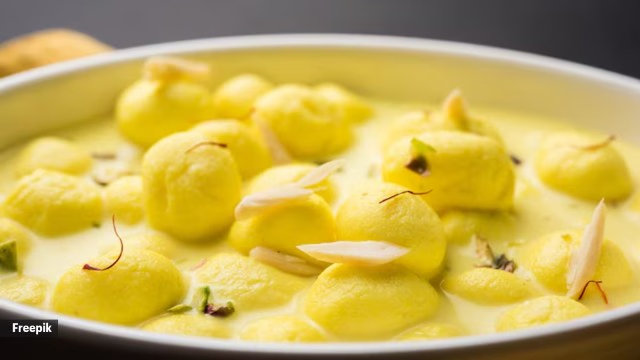What makes Rasmalai the second-best cheese dessert in the world?
- Explore the reasons behind Rasmalai’s reputation as the second-best cheese dessert globally, delving into its rich cultural heritage, delicate flavors, and widespread popularity among dessert enthusiasts worldwide.
According to chef Shaurya Veer Kapoor of Gola Sizzlers, Cafe Hawkers, and Sambar Soul, the Indian subcontinent’s Bengal region is thought to be the recipe’s original home.
There is much more to the world of cheese desserts than just rich, New York-style cheesecakes. Cheese is surprisingly versatile when it comes to sweet delicacies. From ricotta-filled cannoli to the gooey bliss of French cheese fondue,. But the Indian dessert Rasmalai has just surfaced as a rival to the cheesecake throne.
Rasmalai, which Taste Atlas ranked as the second-best cheese dessert in the world, is winning over people’s hearts and palates all over the world.
What then distinguishes Rasmalai so much?
The secret is in its special cheese, chhena. Shena, a fresh cheese created by curdling milk with vinegar or lemon juice, is not to be confused with aged cheeses used in cheesecakes. The light and airy curds that are produced serve as the foundation for the soft, spongy balls that are the essence of Rasmalai.
After simmering in a light sugar syrup, these chenna balls are dipped in the star of the show, Rabdi, a thickened milk flavored with cardamom, almonds, and occasionally even saffron.
The word “rassimalai” literally means “juicy cream,” which is an appropriate way to describe this dish. Chef Shaurya Veer Kapoor of Gola Sizzlers, Cafe Hawkers, and Sambar Soul restaurant discusses the origins of the dish, stating that it is thought to have started in the Bengal region of the Indian subcontinent.
Krishna Chandra Dasm, the founder of K.C. Das Grandsons, confectioners in Kolkata, is credited with creating Rasmalai in the early 1900s. This assertion is corroborated by food historian K.T. Achaya, who proposes that Das developed Rasmalai by building on his father’s invention of Rasgulla (chenna balls). But the Comilla area of Bangladesh adds another twist to the tale. The Sen brothers of Matri Bhandar emphasize their part in popularizing and commercializing the dessert in their claim to be its original founders. For “Comillar Rosmalai,” they have even submitted for a Geographical Indication (GI) designation. Chef Kapoor says, “The precise historical details are not well-documented, but Rasmalai is said to have developed around the 19th century.” He continues, “It is closely related to another well-known Bengali dessert, Rasgulla.” But as it becomes ingrained in South Asian customs, rasamalai transcends its status as a simple dessert and has great cultural significance on the Indian subcontinent. Rasmalai is a common sight during holidays and other significant events. Chef Kapoor says, “Its sweetness is a fitting way to mark joyous occasions like Diwali, Holi, and weddings because it symbolizes prosperity and indulgence.” Not just this. It is an opulent delight, with contrasting flavors and a thick, creamy texture. According to chef Kapoor, “Rasmalai becomes a special occasion dessert, reserved for moments of celebration and shared enjoyment.”
Chef Kapoor has provided this simple-to-make Rasmalai recipe that you may try at home:
Ingredients: ½ cup lemon juice, ½ cup sugar, 2 litres full-fat milk, 4 cups water, a teaspoon of optional saffron threads, and 1 tablespoon of chopped almonds or pistachios for decoration.
Method 1: Prepare the chenna balls by heating one liter of milk to a boil in a heavy-bottomed pan.After the milk reaches a boiling point, turn down the heat to low and gently whisk in the lemon juice, stirring constantly until the milk completely curdles and the whey separates from the milk solids (paneer). If curdling is not quite done, add a little more lemon juice.After turning off the heat, give it a few minutes to cool.
2. Drain the paneer: * Pour the curdled milk through a sieve or muslin cloth set over a bowl; * Rinse the paneer under cold water to get rid of any leftover lemon juice.To eliminate any leftover liquid, hang the paneer for 30 minutes after squeezing out extra water.
3. Knead and shape the paneer: * After draining, knead the paneer for five to seven minutes on a spotless surface, or until it’s smooth and tender.Shape the paneer dough into balls by dividing it into small, equal sections. Press each ball gently to make a small flattening.
4. Prepare the paneer balls: *Mix sugar and water in a separate large pan. * Bring it to a boil and make sure all of the sugar is dissolved.Slide the paneer balls into the boiling syrup with gentle care. Allow the balls to double in size by covering and cooking over medium heat for 15 to 20 minutes.
5. Prepare the Rabdi and assemble: *While the balls are cooking, warm the remaining 1 litre of milk in a another pan and stir in the saffron threads, if using. Simmer it for a few minutes to give it a minor thickening.
*After cooking, remove from the heat and allow the paneer balls to cool in the syrup.After the balls have cooled, gently press off any extra syrup and add them to the thickened milk.
Give them at least an hour to soak in the refrigerator.Add chopped almonds or pistachios as a garnish.
For more information, visit https://watchnewz.com/
